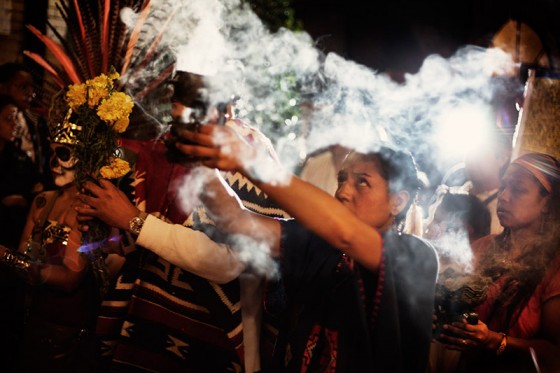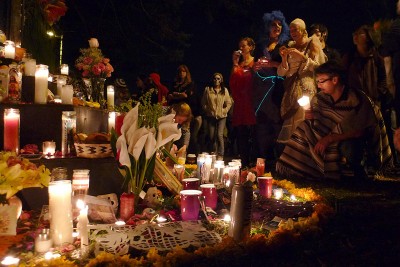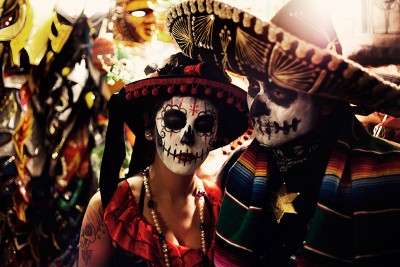
Click here to read our 2015 Día de los Muertos guide!
From skull candies, whimsical masks and altars for the dead, how much do you know about the Mexican holiday, Día de los Muertos (Day of the Dead)?
Getting ready for Día de los Muertos always brings to my mind the people who passed away and left a mark in my heart.
I tell my mother that I have two angels that are looking over me. This Día de los Muertos, I am hoping they come to me and celebrate life. Being far away from the place that I call home, Michoacán, Mexico, I won’t be able to go to my grandfather’s grave and decorate it with flowers.
But I remember my times there as a small girl, playing with cousins in the cemetery while my mother and tias (aunts) prayed for our ancestor’s souls to go heaven. The bright sun shined on the vases of water holding the orange colored flowers called cempasuchil (also known as Mexican marigold).
The kids eat part of the offerings that are served to the spirit of the dead person, while running and playing around the tombs that their family members decorated with flowers and candles.
I remember the colorful skulls candies, the smell of the bread and the Rancheras playing the songs of Jose Alfredo Jimenez, a famous Mexican musician. The lyrics of his songs remind me of my childhood.
Día de los Muertos, or Day of the Dead, is one of my favorite traditions because it involves the spirit and love for our ancestors who come to earth once a year.

The holiday is traditionally celebrated in Mexico but has recently become popular in the United States and other Latin American countries, thanks to the large Mexican diaspora.
In Mexico, the holiday originated in the era of the indigenous communities in Mesoamerica, like the Aztecs, Mayas, Purepechas, Nahuas, and Totonacas. It was common practice to conserve skulls as trophies and show them in rituals that symbolized death and revival.
After the Spaniards conquerors came to America, they were terrified by these pagan practices of indigenous people. As part of an effort to absorb native indigenous rituals into Catholicism, the church moved their rituals to November 2nd, after the catholic celebration of Día de Todos los Santos.
Spaniards combined the traditions of Halloween with the similar festivity of the native indigenous of Mexico, calling that holiday “Día de los Muertos.”
La Catrina, also known as Dama de la Muerte, is a classic symbol seen on the holiday. It was created by Jose Guadalupe Posadas, a famous indigenous artist who became an icon of the Mexican revolution.
The image of the dancing Catrina skull is a work of social satire used to demonstrate the steps of life and that one day death will come for us, whether we’re rich, poor, young or older. The message is that we have to see life as a gift to us, as a celebration that we need to embrace.
The traditions of Día de los Muertos differ in different parts of Mexico. Generally it’s believed that on November 1st the souls of children will come to earth and the adults come on November 2nd.

On these days, people go to the graves of their loved ones and cover them with flowers, and serve them offerings of their favorite food, drinks, even tequila, mescal, agua ardiente or anything else that they used to love when they were alive.
They celebrate at the cemetery for a whole day, and often spend the night, waiting for the spirit of their loved ones to eat and celebrate with them. Families usually clean and decorate the graves with colorful wreaths of flowers like roses and sunflowers, which are believed to attract the souls of the dead. The skull candy is an essential item with the name of the people that died written onto it’s forehead.
If someone cannot go to the graves, they create detailed altars at home with offerings. Everything is put together with the photographs of the deceased and candles all over the altar.
Being far away from home, we have to embrace our roots and traditions that are still very much alive. By remembering our roots, we remember were we come from and that the people that passed away are still in our hearts. This is the day that we as Mexicans get together to celebrate our traditions.
I hope you enjoy Día de los Muertos as much as I do. Here’s how you can take part in the celebrations:
(*Added on 10/29/13) El Centro de la Raza: Día de los Muertos Ofrenda Exhibit and dinner
Friday, Nov. 1 5 pm – 8:30 pm
Ofrenda Exhibit open through November 21
2524 16th Ave South, Seattle WA 98144
Seattle Center: Día de Muertos, A Mexican Celebration to Remember Our Departed (in Spanish). Activities include live performances, hands-on activities, face paintings and making sugar skulls.
Saturday, Oct. 26, 11 am – 7:00 pm
Sunday, Oct. 27, 11 am – 6:00 pm
305 Harrison Street, Seattle, WA 98109
Seattle Art Museum gets together for “Día de los Muertos” to show its beauty. The exhibition of the tapete (sand carpet), based on the tradition of Oaxaca, Mexico, with music performances and traditional food.
October 30–November 10
10 am–5 pm
1300 First Avenue, Seattle WA 98101
Amazing Grace Spiritual Center will be making “Día de los Muertos” memorable in Seattle with an all-ages Masquerade Ball, Mexican food, an altar made by the community.
Friday, November 1
2007 NW 61st St. Seattle, WA 98107
Price $15 – $25 tickets can be bought online or at the door.
Tacoma Art Museum will be establishing its own altar exhibition, along with many different discussions and fun activities that can make your “Día de los Muertos” incredible. The exhibition of the tapete (sand painting), done by Fulgencio Lazo and Jose Orantes should be amazing.
Tapete (Sand Painting) and Altars Installation:
Sunday, October 20 – Sunday, November 3
Día de los Muertos Free Community Festival Sunday, November 3, 10 am–4 pm
1701 Pacific Avenue, Tacoma, WA 98402


Thank you so much for this article. I am taking my Spanish class to a Dia de los Muertos exhibit at Maude Kerns Art Center tomorrow. We will read your article before we leave. It is a wonderful intro to what we will be seeing.
Michelle McLaughlin
Eugene, OR
That’s so great! Thanks for reading and have fun at the exhibit!
Sara McCaslin, Editor
I feel really honor, that you read the article on the Dia de los Muertos Exhibit! If you need to practice your Spanish send me an email at anytime. I hope you enjoy Dia de los Muertos as much as I do.
Thanks for the article!
Just wanted to add to the events the Día de los Muertos Ofrendas Exhibit and opening ceremony at El Centro de la Raza. http://elcentrodelaraza.wordpress.com/2013/10/18/dia-de-los-muertos-opening-ceremony-november-1st-5-830-pm/
The opening ceremony is this Friday Nov 1 from 5:00-8:30pm, and the exhibit is open during the week through Nov 21st. A beautiful and important event in our community.
Thanks!
Thanks Clara! We will get this posted–you can also submit events directly here:
https://seattleglobalist.com/events/community/add
Updated! Thanks for the addition, a silly oversight on our part, haha.
Sara McCaslin, Editor
Thank you Clara! It really is important, is part of our beautiful traditions.